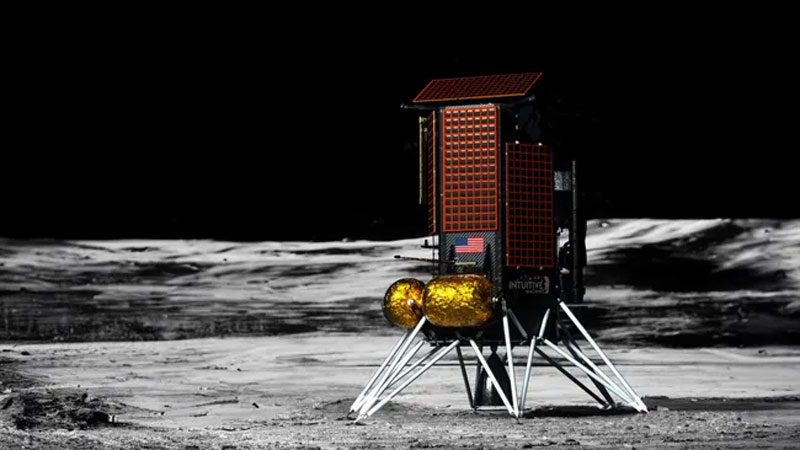NASA has assigned Intuitive Machines another mission to deliver scientific instruments to the Moon.


With difficulty, the landing of the Nova-C lunar module, nicknamed “Odyssey,” on the surface of the Moon was the first for the United States in more than 50 years. This feat was accomplished by the private company Intuitive Machines and promises to do it twice and even three more times, as it recently signed a new contract with NASA. For $116.9 million, the company will deliver six of the agency’s scientific instruments to the satellite’s south pole in 2027.


As intended. Image source: Intuitive Machines
IM-1’s historic mission ended on February 29, 2024. It became one of the successes of NASA’s program to attract private business and non-governmental engineering personnel to space programs. The agency seeks to shift the burden of financial burden from the budget to entrepreneurs, without which widespread exploration of outer space would be unthinkable.
Not everything goes smoothly. The company’s Nova-C module tipped over on its side after touching the lunar surface. Yet it delivered a payload, including NASA instruments, to the lunar surface. Thus, the main goal of the IM-1 mission was fulfilled. The module descended to 80.13° south latitude. According to NASA metrics, there was only 0.13° left to the satellite’s south pole region. Almost bull’s eye. The agency paid the company for two more missions to deliver loads to the south pole region: one of them will take place before the end of this year, and the second in 2025. We can now legitimately expect another mission, IM-4, in 2027.
How did it happen
NASA explained that during the IM-4 mission, the company will deliver six scientific instruments with a total mass of 79 kg to the satellite’s south pole. All of them, one way or another, will be focused on searching for traces of volatile substances near the surface of the Moon, as well as at a depth of up to one meter. First of all, it will be water, but also any other gaseous substances. The South Pole of the Moon is a promising place for organizing bases for long-term human presence. But they will become a reality only if sufficient reserves of water are discovered on the satellite – this is a source of oxygen for breathing and fuel, as well as water itself to ensure the life of people, plants and living organisms.
By the way, one of the payloads of the IM-4 mission will be the Lunar Explorer instrument with colonies of live yeast. This will be a NASA program that will study the effects of microgravity and radiation on yeast. The European Space Agency will send a privately owned mini-rig to the Moon. It will drill into the soil to a depth of 1 m in search of frozen volatile substances (water, ice, gases). Samples will be analyzed on site in a mini-laboratory.
How will it be
Another device will be a corner reflector for detecting the landing module from orbit. The device promises to be more utilitarian for detecting contamination of the landing site by module engine exhaust: it is clean not where it is cleaned, but where it is not littered. NASA has decided to find out to what extent the presence of terrestrial equipment on the Moon can contaminate samples from its surface.
The magnetic fields and trajectories of charged particles near the surface of the Moon will be tracked by NASA’s Fluxgate magnetometer. More interesting is the Lunar Compact device – a sensor for studying the surface of the Moon in a wide spectrum of infrared radiation. The sensor will not only help create an accurate map of the temperature distribution on the surface of the satellite, but will also help identify useful deposits.
Recent Posts
A demo of Dispatch, a comedy game about a superhero agency from the former developers of Tales from the Borderlands and The Wolf Among Us, has been released on Steam
Developers from the American AdHoc Studio, founded by former Telltale Games, Ubisoft and Night School…
Digma DP-FHD800A LCD Full HD Projector Review: A Modern Approach
When you think about a home theater, you immediately imagine bulky projectors with a bunch…
Lian Li Introduces HydroShift II LCD-C Liquid Cooling System with 360mm Radiator and Three Configurations
Lian Li has introduced a series of maintenance-free liquid cooling systems HydroShift II LCD-C. It…
Apple: App Store App Developers to Earn $406 Billion in 2024
Amid mounting pressure from U.S. regulators, Apple has released the results of an independent study…
ASRock Admits Its Motherboards Break Ryzen 9000 Processors
Following a report from YouTube channel Tech Yes City that ASRock linked Ryzen 9000 processor…
Apple to Change OS Numbering: iOS 26 to Come This Year Instead of iOS 19
Apple is preparing a large-scale rebranding of its line of operating systems. This was reported…